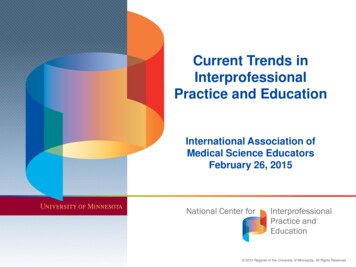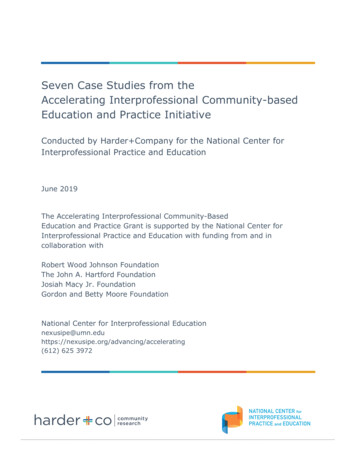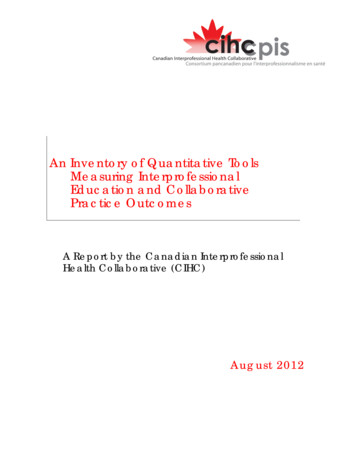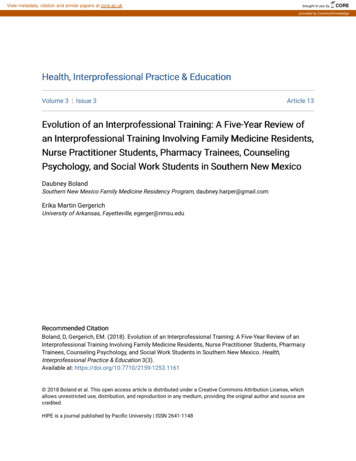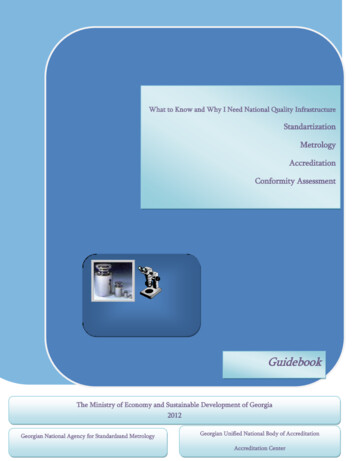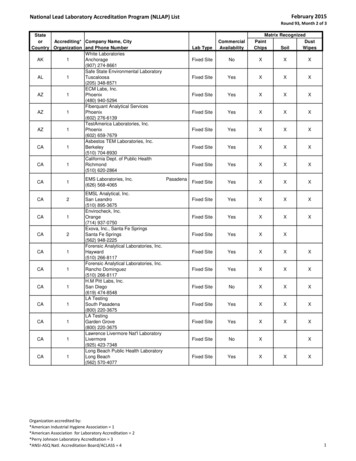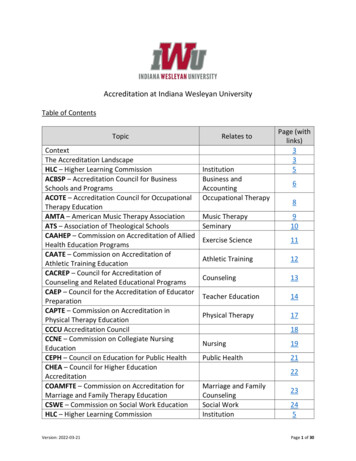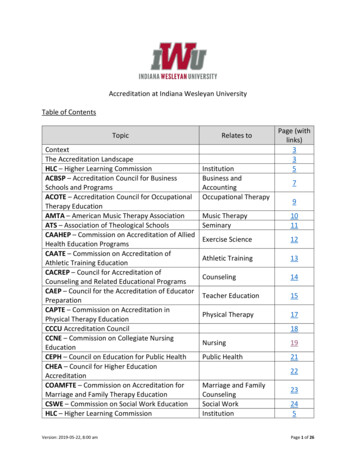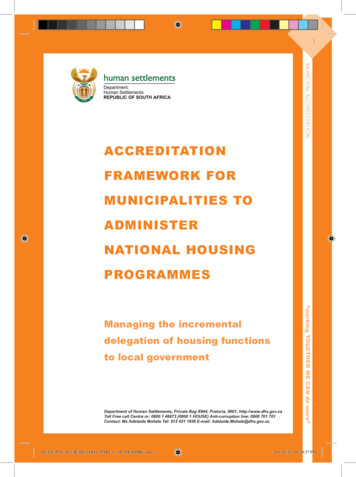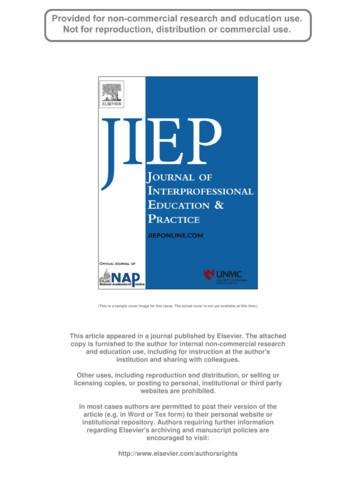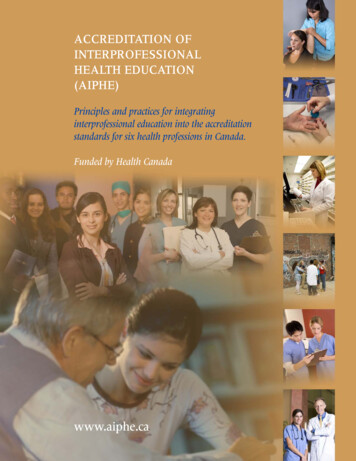
Transcription
ACCREDITATION OFINTERPROFESSIONALHEALTH EDUCATION(AIPHE)Principles and practices for integratinginterprofessional education into the accreditationstandards for six health professions in Canada.Funded by Health Canadawww.aiphe.ca
ACCREDITATION OFINTERPROFESSIONALHEALTH EDUCATION(AIPHE)Principles and practices for integratinginterprofessional education into the accreditationstandards for six health professions in Canada.Funded by Health Canada
iiP r i n c i p l e s a n d p r a c t i c e s fo r i n t e g r a t i n g i n t e r p r o fe s s i o n a l e d u c a t i o n i n t o t h e a c c r e d i t a t i o n s t a n d a r d s fors i x h e a lth p r ofessions in Canad a.
TABLE OF CONTENTSAcknowledgements . . . . . . . . . . . . . . . . . . . . . . . . . . . . . . . . . . . . . . . . . . . . . . . . 3Abstract.7Introduction . . . . . . . . . . . . . . . . . . . . . . . . . . . . . . . . . . . . . . . . . . . . . . . 8Why interprofessional education for collaborativepatient-centred practice? . . . . . . . . . . . . . . . . . . . . . . . . . . . . . . . . . . . . . 9The connection between interprofessional education andaccreditation of professional education programs . . . . . . . . . . . . . . . . . . . 10Guiding Principles for integrating interprofessional educationstandards into professional education . . . . . . . . . . . . . . . . . . . . . . . . . . . . . 10Implementation of interprofessional education accreditationstandards: knowledge to action . . . . . . . . . . . . . . . . . . . . . . . . . . . . . . . . . . . . 11Examples of standards . . . . . . . . . . . . . . . . . . . . . . . . . . . . . . . . . . . . . . . . . 12Examples of evidence . . . . . . . . . . . . . . . . . . . . . . . . . . . . . . . . . . . . . . . . . . 12Resources. . . . . . . . . . . . . . . . . . . . . . . . . . . . . . . . . . . . . . . . . . . . . . . . . . . . . . . 14Curriculum: academic or course-based setting . . . . . . . . . . . . . . . . . . . . . . 14Curriculum: practice or clinical setting . . . . . . . . . . . . . . . . . . . . . . . . . . . . 15Faculty Teaching Skills . . . . . . . . . . . . . . . . . . . . . . . . . . . . . . . . . . . . . . . . . 15Evaluation . . . . . . . . . . . . . . . . . . . . . . . . . . . . . . . . . . . . . . . . . . . . . . . . . . . 16Key Literature References . . . . . . . . . . . . . . . . . . . . . . . . . . . . . . . . . . . . . . 16Appendices. . . . . . . . . . . . . . . . . . . . . . . . . . . . . . . . . . . . . . . . . . . . . . . . . . . . . . 17Glossary of Terms . . . . . . . . . . . . . . . . . . . . . . . . . . . . . . . . . . . . . . . . . . . . . 17Professional Entry-level Credentials . . . . . . . . . . . . . . . . . . . . . . . . . . . . . . 18References . . . . . . . . . . . . . . . . . . . . . . . . . . . . . . . . . . . . . . . . . . . . . . . . . . . 19Existing Standards relevant to IPE . . . . . . . . . . . . . . . . . . . . . . . . . . . . . . . . 201P r i n c i p l e s a n d p r a c t i c e s fo r i n t e g r a t i n g i n t e r pr o fe s s i o n a l e d u c a t i o n i n t o t h e a c c r e d i t a t i o n s t a n d a r d s forsix health p r ofessions in Canad a.
2P r i n c i p l e s a n d p r a c t i c e s fo r i n t e g r a t i n g i n t e r p r o fe s s i o n a l e d u c a t i o n i n t o t h e a c c r e d i t a t i o n s t a n d a r d s fors i x h e a lth p r ofessions in Canad a.
ACKNOWLEDGEMENTSThe Principles and Implementation Guide, which includes sample standards andcriteria, and a list of resources, have been developed by the AIPHE SteeringCommittee, through a consultation process with the AIPHE Advisory Group. Thecontributions provided by organizations and individuals are greatly appreciated.Funding has been generously provided by Health Canada.The Steering Committee would like to sincerely thank Lesley Bainbridge andLouise Nasmith for their extra efforts in developing this Principles andImplementation Guide.PARTICIPATING ORGANIZATIONS Accreditation Council of Canadian Physiotherapy Academic Programs(ACCPAP) Canadian Association of Occupational Therapists (CAOT) Canadian Association of Schools of Nursing (CASN) Canadian Association for Social Work Education (CASWE) Canadian Council for Accreditation of Pharmacy Programs (CCAPP) College of Family Physicians of Canada (CFPC) Committee on Accreditation of Canadian Medical Schools (CACMS) Royal College of Physicians and Surgeons of Canada (RCPSC)STEERING COMMITTEEDianne Delva, MD, FCFP, Co-Chair, Associate Dean, Undergraduate Medicine,Dalhousie UniversityMary Ellen Jeans, RN, PhD, Co-Chair, President and CEO, AssociatedMedical Services (AMS) Inc.Lesley Bainbridge, BSR(PT), MEd, PhD (c), Representing: AccreditationCouncil for Canadian Physiotherapy Academic Programs (ACCPAP),Associate Principal, Interprofessional Education, College of HealthDisciplines, Director Interprofessional Education, Faculty of Medicine,University of British ColumbiaRichard Birtwhistle, MD, MSc, FCFP, Representing: Committee onAccreditation of Canadian Medical Schools (CACMS), Professor, FamilyMedicine and Community Health and Epidemiology, Director, Centre forStudies in Primary Care, Queen's University3P r i n c i p l e s a n d p r a c t i c e s fo r i n t e g r a t i n g i n t e r pr o fe s s i o n a l e d u c a t i o n i n t o t h e a c c r e d i t a t i o n s t a n d a r d s forsix health p r ofessions in Canad a.
Grant Charles, PhD, Representing: Board of Accreditation of the CanadianAssociation for Social Work Education (CASWE), Associate Professor,School of Social Work, University of British ColumbiaDavid S. Hill, EdD, FCSHP, Representing: Canadian Council forAccreditation of Pharmacy Programs (CCAPP), Executive DirectorMargaret Kennedy, MA, Representing: The Royal College of Physicians andSurgeons of Canada, Assistant Director, Accreditation & LiaisonLouise Nasmith, MDCM, MEd, CCFP, FCFP, Representing: College of FamilyPhysicians of Canada (CFPC), Principal, College of Health Disciplines,University of British ColumbiaEllen Rukholm, RN, PhD, Representing: Canadian Association of Schoolsof Nursing (CASN), Executive DirectorKathy Van Benthem, MHS OT Reg (Ont), Representing: CanadianAssociation of Occupational Therapists (CAOT), Director of Policy andStandardsAccreditation Canada RepresentativeSuzanne Larocque, MSW, Director, People Services, Accreditation CanadaInterprofessional EducatorsRuby Grymonpre, PharmD, FCSHP, Professor, Faculty of Pharmacy, IPECoordinator, IPE Initiative, University of ManitobaCarole Orchard, BSN, MEd., EdD, Associate Professor, Coordinator,Interprofessional Health Education & Research, University of WesternOntario, Associate Professor, Faculty of Health Sciences & SchulichSchool of Medicine & Dentistry, University of Western OntarioEx-Officio MembersSue Maskill, BSc, Vice-President, Education and Special Projects, TheAssociation of Faculties of Medicine of Canada (AFMC)Theresa Schopf, RPh, MBA, Office of Nursing Policy, Health CanadaProject StaffCatherine Moffatt, MEd, Project Manager, The Association of Faculties ofMedicine of Canada (AFMC)Claire de Lucovich, BSc, Project Assistant, The Association of Faculties ofMedicine of Canada (AFMC)4P r i n c i p l e s a n d p r a c t i c e s fo r i n t e g r a t i n g i n t e r p r o fe s s i o n a l e d u c a t i o n i n t o t h e a c c r e d i t a t i o n s t a n d a r d s fors i x h e a lth p r ofessions in Canad a.
ADVISORY GROUPConstance Barlow, PhD, Professor, Faculty of Social Work, University ofCalgaryCathryn Beggs, BScPT, MSc, Executive Director, Accreditation Council forCanadian Physiotherapy Academic Programs (ACCPAP)Marion Brown, PhD, RSW, Assistant Professor, School of Social Work,Dalhousie UniversityPamela C. Fralick, MA, President and Chief Executive Officer, CanadianHealthcare Association (CHA)Alex Harris, RN, Past-President, National Health Sciences Students’ Association(NaHSSA)Fleur-Ange Lefebvre, PhD, Executive Director and CEO, Federation ofMedical Regulatory Authorities of Canada (FMRAC)Jason Nickerson, BHSc, RRT(AA), MA(c), President, National Health SciencesStudents’ Association (NaHSSA)Margo Paterson, MSc, PhD, OT Reg (Ont) OT (C), Chair, OccupationalTherapy Program School of Rehabilitation Therapy, Queen’s UniversityH.J. Polatajko, PhD, OT Reg (Ont), OT(C), FCAOT, Professor andFormer Chair, Department of Occupational Science and OccupationalTherapy, Graduate Department of Rehabilitation Science, University ofTorontoSandy Rennie, PT, PhD, Associate Professor and Director, School ofPhysiotherapy, Dalhousie UniversityJoan Sayer, BSc, Consumers’ Association of CanadaRobert Sindelar, PhD, Dean, Faculty of Pharmaceutical Sciences,University of British ColumbiaPatricia Strachan, RN, PhD, Assistant Professor, School of Nursing,McMaster UniversityLise Talbot, inf., psy., PhD, Professeure titulaire, École des sciencesinfirmières, Université de SherbrookeNancy M. Waite, PharmD, FCCP, Associate Director, Practice-Based Education,Associate Professor, School of Pharmacy, University of WaterlooDeborah Wolfe, P.Eng., Director, Education, Outreach and Research,Engineers CanadaBob Woollard, MD, CCFP, FCFP, Professor, Department of Family Practice,University of British Columbia5P r i n c i p l e s a n d p r a c t i c e s fo r i n t e g r a t i n g i n t e r pr o fe s s i o n a l e d u c a t i o n i n t o t h e a c c r e d i t a t i o n s t a n d a r d s forsix health p r ofessions in Canad a.
6P r i n c i p l e s a n d p r a c t i c e s fo r i n t e g r a t i n g i n t e r p r o fe s s i o n a l e d u c a t i o n i n t o t h e a c c r e d i t a t i o n s t a n d a r d s fors i x h e a lth p r ofessions in Canad a.
ABSTRACTInterprofessional education (IPE) is increasingly important in health professionaleducation. It is an educational approach that helps to prepare the future health andhuman service workforce for interprofessional collaboration. Working together moreeffectively across professions and inclusion of the patient/client/family at the centreof care are both critical for mitigating health human resource shortages and forimproving patient safety.To help to ensure that interprofessional education (IPE) is embedded in health andhuman service education programs in Canada, Health Canada funded sixprofessions (medicine, nursing, pharmacy, physical therapy, occupational therapy,and social work) representing eight accreditation bodies to work together to addressinterprofessional education in accreditation standards. With secretariat support fromThe Association of Faculties of Medicine of Canada, a Steering Committee and anexpanded Advisory Group worked to develop shared principles in support ofaccreditation standards for IPE. The resulting document describes the rationale forthis attention to IPE, articulates guiding principles, provides sample standards andexamples of evidence, as well as a resource list for education programs to accessmaterial needed to embed IPE in curricula.Future activities will be undertaken by each accrediting body to frame the IPEstandards in their language. The 8 organizations represented by AIPHE will continueto share experiences and lessons learned through standard development andimplementation processes. In addition, the work of AIPHE will be shared with otherinterested accreditation bodies to be used as a base from which to develop IPEstandards.7P r i n c i p l e s a n d p r a c t i c e s fo r i n t e g r a t i n g i n t e r pr o fe s s i o n a l e d u c a t i o n i n t o t h e a c c r e d i t a t i o n s t a n d a r d s forsix health p r ofessions in Canad a.
INTRODUCTIONIn November of 2007, Health Canada provided funding to bring six health andhuman service professions (medicine, nursing, occupational therapy, pharmacy,physical therapy and social work) together to address the integration of IPEstandards into each profession’s education accreditation program. The Association ofFaculties of Medicine (AFMC) provided the secretariat for the Accreditation forInterprofessional Health Education (AIPHE) group.1 A Steering Committee,Management Sub-Committee, and Advisory Group worked together over 18months to develop principles, sample standards and criteria, and an implementationguide, including a list of resources, for the integration of IPE into national healthand human service accreditation standards. In addition, Accreditation Canada(formerly the Canadian Council of Health Services Accreditation, CCHSA), wasasked by the Steering Committee to participate to ensure that the service deliverycontext which influences practice education for the 6 health and human serviceprofessions was considered. An environmental scan ental-scan.html) was conducted to form a commonunderstanding of interprofessional education as it is reflected currently in theliterature, in Canadian policy, and in practice. This common understanding helpedto lay a strong foundation for the work of AIPHE.Interprofessional health education (IPE) is defined in the literature most commonlyas “occasions when two or more professions learn with, from and about each otherto improve collaboration and quality of care” (CAIPE, 2002). It is a specificeducational approach to learning that requires interaction among learners fromdifferent professions.It is not: a collective of learners from different professions sitting in the same roomlistening to the same lecture; or learners from one profession sharing knowledge with one or more otherprofessions in a one way exchange.One of the primary keys to effective interprofessional education is the activeengagement of students from different professions in interactive learning –something must be exchanged among and between learners from differentprofessions that changes how they perceive themselves and others. These changesmust positively affect clinical practice in a way that enhances interprofessional18Note: for consistency, “Inter-Professional” and “Inter-professional” have been changed to“Interprofessional” throughout this text.P r i n c i p l e s a n d p r a c t i c e s fo r i n t e g r a t i n g i n t e r p r o fe s s i o n a l e d u c a t i o n i n t o t h e a c c r e d i t a t i o n s t a n d a r d s fors i x h e a lth p r ofessions in Canad a.
collaboration, client involvement in care, and ultimately improves health outcomes.IPE is a complex educational approach that is most effective when integratedthroughout a program of study in both academic and practice learning as thestudent moves from simple to more complex learning activities.WHY INTERPROFESSIONAL EDUCATION FORCOLLABORATIVE PATIENT – CENTRED PRACTICE?Interprofessional education (IPE) for collaborative patient-centred practice (CPCP) isemerging as a critical component of health professional education in Canada andinternationally. Interprofessional collaboration is a key strategy for improving healthoutcomes and patient safety as well as for addressing the looming health humanresource crisis in health care. It is believed to have the potential for: improvingprofessional relationships; increasing efficiency and coordination; increasing patientsafety and reducing medical errors; decreasing cost of care; enhancing provider andpatient satisfaction; and ultimately enhancing patient and health outcomes(Baldwin, 1996; Cullen, Fraser & Symonds, 2003; Institute of Medicine, 2003:Reeves & Freeth, 2002; Wee, Hillier & Coles, 2001). In addition, it is widely knownthat the needs of many patients are beyond the expertise of any single professionand genuine patient-centered service requires interprofessional collaborative care(Freeth, 2001).IPE is one of the vital strategies that education programs can employ to preparehealth care providers to participate in a new, more collaborative,future health careworkforce. New federal and provincial policies indicate that IPE and collaborativecare are expectations for future practice. Government funding has supported avariety of initiatives to promote IPE and CPCP.Despite the increasingly strong IPE movement, there are challenges to considerwhen planning for IPE in both academic and clinical settings. Challenges includedifferences in the routines of work clinically, and in educational requirements;rotations, methods of evaluation, and tuition that are separately defined;scheduling challenges; variation in learners’ age, educational level and clinicalexperience; differences in academic policies; complexity of the design required forIPE and the considerable commitment and time required; attitudinal barriers;differences in language and in the interpretation of that language; historical rivalriesamong the professions; and fears of dilution of professional identities (McPherson,Headrick & Moss, 2001). Careful planning, appropriate resources, and attention tochange management may help to ameliorate the challenges9P r i n c i p l e s a n d p r a c t i c e s fo r i n t e g r a t i n g i n t e r pr o fe s s i o n a l e d u c a t i o n i n t o t h e a c c r e d i t a t i o n s t a n d a r d s forsix health p r ofessions in Canad a.
THE CONNECTION BETWEENINTERPROFESSIONAL EDUCATION ANDACCREDITATION OF PROFESSIONALEDUCATION PROGRAMSTo ensure that education programs place IPE high on their educational priority list,Health Canada funded a collaborative project, the Accreditation for InterprofessionalHealth Education (AIPHE), that brought together six key health professions toaddress IPE in accreditation standards.The six health and human service professions represented in the AIPHE projecthave committed to working collaboratively in the development of shared principlesand exemplars of standards for the accreditation of interprofessional education innational health and human service education programs. Each professionrepresented is dedicated to making changes to its respective accreditation programto reflect the emerging focus on collaborative practice. By reaching consensus on acommon lexicon, by capitalizing on similarities inherent in IPE, and by creatingflexibility in the standards and evidence that will embed IPE into curricula, the sixprofessions have modeled interprofessional collaboration.GUIDING PRINCIPLES FOR INTEGRATINGINTERPROFESSIONAL EDUCATION STANDARDSINTO PROFESSIONAL EDUCATIONThe following principles will guide the development and implementation of IPEstandards in national and, where relevant, international accreditation programs forhealth and human service professional education. The patient/client/family is the central focus of effective interprofessionalcollaboration and, therefore, of effective interprofessional education. In order to educate collaborative practitioners, interprofessional education isan integral component of education for all health and human serviceprofessions. Interprofessional education is most effective when integrated explicitly intoacademic and practice or clinical contexts for learning. Core competencies for collaborative practice are used to inform health andhuman service interprofessional curricula in Canada.10P r i n c i p l e s a n d p r a c t i c e s fo r i n t e g r a t i n g i n t e r p r o fe s s i o n a l e d u c a t i o n i n t o t h e a c c r e d i t a t i o n s t a n d a r d s fors i x h e a lth p r ofessions in Canad a.
Interprofessional education embraces a relationship-centred approach as oneof the key pillars of successful interprofessional collaboration. Interprofessional education requires active engagement of students across theprofessions in meaningful and relevant collaboration. Flexibility in the integration of IPE into health and human service curriculafacilitates the development of accreditation standards that are consistent witheach of the profession’s accreditation process and the diverse educationalmodels across the country. Accreditation as one quality monitoring process for education, and regulation(licensing) as the quality control process for practice, must provide consistentmessages about interprofessional education and collaboration. Emerging evidence is used to guide interprofessional education in all healthand human service program curricula. Required support structures for interprofessional education should beconsidered in all aspects of accreditation including institutional commitment,curriculum, resources, program evaluation, faculty and students. Collaborative learning is integrated along the continuum of healthprofessional education. Specific knowledge, skills and attitudes are required for effectiveinterprofessional collaboration and these are reflected in IPE curricula.IMPLEMENTATION OF INTEPROFESSIONALEDUCATION ACCREDITATION STANDARDS:KNOWLEDGE TO ACTIONThe guiding principles provide the overarching direction for the development ofaccreditation standards that incorporate IPE. The implementation guide providesstructure, process and outcome considerations to enable the development ofstandards and an implementation process. The guide offers sample standards,criteria, examples of evidence and explanatory notes. Given the differentapproaches to the development and implementation of accreditation standardsacross professions, each accreditation agency may use different components of theguide and adapt them for its use. In addition, the guide provides links toresources that will assist education programs to make curricular changes insupport of the IPE standards.11P r i n c i p l e s a n d p r a c t i c e s fo r i n t e g r a t i n g i n t e r pr o fe s s i o n a l e d u c a t i o n i n t o t h e a c c r e d i t a t i o n s t a n d a r d s forsix health p r ofessions in Canad a.
EXAMPLES OF STANDARDS AND EVIDENCEAccreditation standards for IPE may be new standards in an accreditation programor existing standards may be adapted to reflect interprofessional education. In eithercase, the following examples of IPE standards and evidence of IPE may assistprofessions to embed IPE into their national accreditation programs.SAMPLE STANDARDS1. Institutional CommitmentExamples of Standards: The university’s vision, mission, goals, and strategic plan reflect acommitment to innovative teaching practices and collaborative learningexperiences which indirectly support interprofessional education (IPE) Resources are committed for innovative teaching and learning whichindirectly advance IPEExamples of Evidence: Clear interpretation of the vision/mission/goals/strategic plan of theuniversity in the program’s IPE program An office or other organizational unit that is specifically resourced toadvance IPE2. Academic ProgramExamples of Standards: The program’s learning outcomes/objectives/exit competencies explicitlyinclude interprofessional collaborative practice (IPC) IP learning opportunities are provided for all students Student assessment includes evaluation of IP collaborative practicecompetenciesExamples of Evidence: Interprofessional learning objectives throughout course syllabi Experiences of IPE in the academic or course-based setting Practice-based experiences in IPC e.g. Collaborative LearningUnit/Collaborative Learning Environment; IP team rounds; inteprofessionalrural placements Assessment tools used to evaluate collaborative practice competencies e.g.Team Objective Structured Clinical Examination (TOSCE) A coordinating committee or structure for health profession programs is inplace that provides administrative support to the curricular activities across allprograms12P r i n c i p l e s a n d p r a c t i c e s fo r i n t e g r a t i n g i n t e r p r o fe s s i o n a l e d u c a t i o n i n t o t h e a c c r e d i t a t i o n s t a n d a r d s fors i x h e a lth p r ofessions in Canad a.
3. StudentsExamples of Standards: Supports and services are provided to facilitate students’ IP learningExamples of Evidence: Support for a Health Sciences Student Association (HSSA) Opportunities for social interactions Opportunities for students to become engaged in organizing and planninginterprofessional learning experiences4. FacultyExamples of Standards: The common values shared by all faculty, both academic and practice-based,reflect a commitment to interprofessional education and interprofessionalcollaboration Resources are available to ensure that faculty are adequately prepared,supported, and rewarded for engagement in interprofessional educationExamples of Evidence: A commitment to IPE is part of the faculty selection process Interprofessional education involvement is included in the faculty evaluationprocess Interprofessional education activities are recognized and rewarded throughawards and in the promotion and tenure process Faculty/professional development programs are available in interprofessionaleducation5. ResourcesExamples of Standards: Fiscal, physical, and human resources are dedicated to support the planning,implementation, and maintenance of IPE in both the academic institutionsand practice sitesExamples of Evidence: Budget planning explicitly includes resources for IPE Learning resources for IPE are available Funded faculty are provided with dedicated time for IPE Clinical sites have space and other resources dedicated to interprofessionaleducation and interprofessional collaboration Preceptors in the practice setting are oriented to interprofessional education13P r i n c i p l e s a n d p r a c t i c e s fo r i n t e g r a t i n g i n t e r pr o fe s s i o n a l e d u c a t i o n i n t o t h e a c c r e d i t a t i o n s t a n d a r d s forsix health p r ofessions in Canad a.
RESOURCESTo assist education programs to develop interprofessional education resources and toembed interprofessional learning in both academic and clinical settings, there areseveral useful references and links to curriculum, professional development andevaluation materials. The following section provides a selection of references andlinks to resource materials. In addition, a more comprehensive overview ofresources related to learning outcomes, curriculum design, and evaluation oflearning can be found on the AIPHE web site at www.aiphe.caCURRICULUM RESOURCES FOR THE ACADEMIC ORCOURSE-BASED SETTINGThe Canadian Interprofessional Health Collaborative(www.cihc.ca) offers a varietyof resource materials including course outlines, modules, and other teachingmaterials.Specific document of interest:Curricula Approaches of the 20 Health Canada Funded IECPCP Projects(Sept. 2008) www.cihc.ca/about/curricula.html (See Appendix B for acomposite listing of all types of learning materials used in projects)The College of Health Disciplines at the University of British Columbia(www.chd.ubc.ca) offers resources and references for the academic and practice orclinical settings.The Interprofessional Network of BC (In-BC) (www.in-bc.ca) offers examples ofinterprofessional activity in both academic and practice settings.Interprofessional Case studiesCase studies are available in print, DVD, with and without instructor guides, andtemplate formats from the following education institutions in Canada:University of Toronto, Office of Interprofessional Education (www.ipe.utoronto.ca)The University of Western Ontario, Office of Interprofessional Health Education &Research (www.ipe.uwo.ca)Also consult the CIHC e-Library for access to other case studies from IECPCPprojects (www.cihc.ca/library)14P r i n c i p l e s a n d p r a c t i c e s fo r i n t e g r a t i n g i n t e r p r o fe s s i o n a l e d u c a t i o n i n t o t h e a c c r e d i t a t i o n s t a n d a r d s fors i x h e a lth p r ofessions in Canad a.
For simulated cases a set of templates is also available through the University ofWestern Ontario, see www.ipe.uwo.caCURRICULUM RESOURCES FOR THE PRACTICE ORCLINICAL SETTINGThe Interprofessional Rural Program of BC (www.irpbc.com) offers informationabout interprofessional clinical experiences in rural communities.The University of Western Ontario Office of Interprofessional Health Education &Research (www.ipe.uwo.ca) has a set of tools used for all IPE student placements: Evaluation of IPE Placement (completed by prelicensure students) IPE peer/self Group Interaction Assessment IP Student Team Learning Plan Evaluation of Interprofessional Education Practice Facilitators (completed bypre licensure students of their faculty member)RESOURCES TO DEVELOP FACULTY TEACHING SKILLS IN IPEPrograms to develop IP teaching skills for faculty members have been developed atseveral universities listed below.Contacts for the following can be found at www.cihc.ca/library University of Toronto Office of IPE offers a one week training program inIPE for faculty. The University of Western Ontario has developed an IPE Faculty TeachingCertificate Program. Université Laval – Practice training in Primary Care Teaching Environmentvideos to support faculty in their practice teaching roles Dalhousie University – Interprofessional Orientation for faculty andclinicians using web-CT discussions, teleconferencing, and face-to-facediscussions. McGill University provides a Faculty Development Program comprised ofcase studies, an instructor manual, and on-line documents; they also providea workshop on Building Resources and Tools to Facilitate Teaching ofInterprofessional Collaborative Practice that incorporates 6 on-line cases andcare plans for clinicians.15P r i n c i p l e s a n d p r a c t i c e s fo r i n t e g r a t i n g i n t e r pr o fe s s i o n a l e d u c a t i o n i n t o t h e a c c r e d i t a t i o n s t a n d a r d s forsix health p r ofessions in Canad a.
University of New Brunswick at Saint John provides training forEducator’s in Knowledge of Core Competencies Required to SupportCollaborative Patient-Centred Practice Institute of Interprofessional Health Sciences Education has developeda set of 4 modules for team development of clinicians focusing oncollaborative team work. University of Manitoba has developed an Inter
9 Principles and practices for integrating interprofessional education into the accreditation standards for six health professions in Canada. collaboration, client involvement in care, and ultimately improves health outcomes. IPE is a complex educational approach that is most effective when integrated
